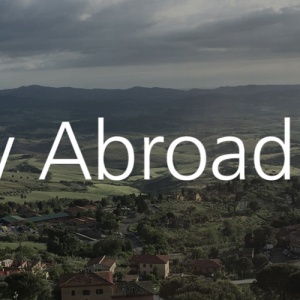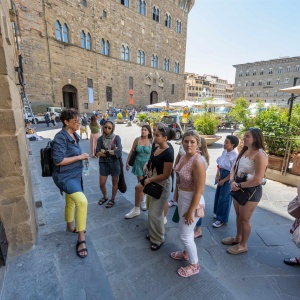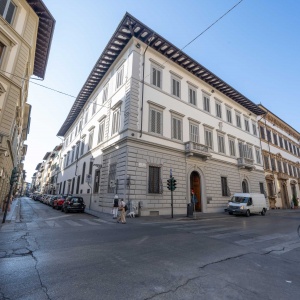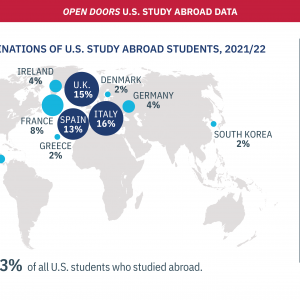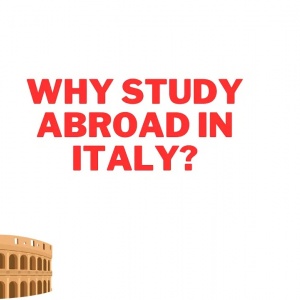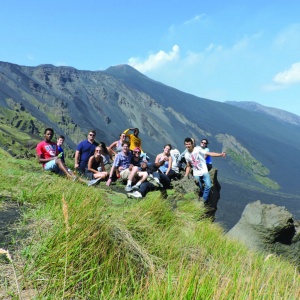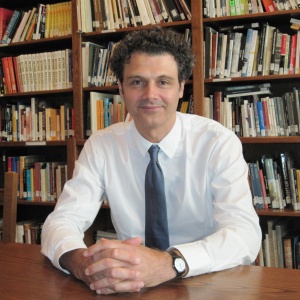
Fabrizio Ricciardelli (President of the Association of American College and University Programs in Italy)
Studiare in Italia, un'esperienza che cambia la vita ogni anno a 40.000 studenti americani

For those who like us are relentlessly dedicated to promoting everything related to the relationship between Italy and the United States, with a special eye on the Italian American community, the phenomenon of study abroad that brings thousands of American students to Italy every year is extremely important.
The Association of American College and University Programs in Italy is in charge of representing and bringing together the vast majority of these academic programs, and today we are pleased to welcome and host on We the Italians the new President of this vital institution, Professor Fabrizio Ricciardelli.
Professor, you are the President of the Association of American College and University Programs in Italy (AACUPI). Can you tell us the history, activities and numbers of the association?
AACUPI gathers and represents, since 1978, 145 U.S., Canadian, British and Australian institutions that have established a stable academic presence in Italy. Over sixty AACUPI institutions are concentrated in and around the city of Rome (Bracciano, Marino, Ariccia) and over fifty operate in Florence and more generally in Tuscany (Arezzo, Siena, Cortona, Sansepolcro, Montepulciano, etc.). Many others operate in the Italian cities of Bologna, Parma, Venice, Padua, Genoa, Milan, Ascoli Piceno, Sorrento, Paderno del Grappa, Turin, Perugia, Orvieto, etc.
The economic importance for Italy is surprising, because according to data collected by IRPET (Regional Institute for Economic Planning of Tuscany), and soon to be published by AACUPI in 2024, in Academic Year 2023 alone, the economic impact of AACUPI's subsidiaries on our country was about 900 million euros, while the number of people employed in this sector was more than 11,000. Not bad, I would say!
In addition, American universities bring wealth and investment to Italy, just think of the recovery of important properties otherwise destined for ruin, and which have returned to new life by becoming home to Italian academic activities and centers of high culture and research.
Over the years, AACUPI has become the point of reference for both Italian and U.S. authorities for everything related to Study Abroad in Italy, succeeding, among other things, in getting (a unique case in the world) specific regulations passed for the sector, which has given it further and decisive development (for example, Law 4/1999-which we call the “Barile Law,” because it was prepared by the late Prof. Paolo Barile - which provides the legal framework within which our institutions can operate in Italy; and Article 38-bis of the Consolidated Immigration Act, which has greatly simplified the stay of our students).
You are also the director of the Kent State University Florence Center. Can you tell us a little about the lives of American students who come from the university that has its headquarters in Ohio to study with you?
Our mission at Kent State University Florence is to provide an educational experience for students that is able to transform them into citizens of the world. We are aware that we play a role that as educators has definite responsibilities. Our goal is not just to pass on a package of information or notions, but to try to expose our students to a different system of life, values and thinking than the one from which they came.
At the center of our interest is the student person even before the professional student. This means not just offering courses within the classrooms of our institution, but to design learning opportunities that take advantage of the city of Florence with its institutions, its museums, its cultural associations, its business realities and the whole community. The city becomes a laboratory in which to learn but also to exchange knowledge and through which to mature skills and sensibilities.
For our students we organize field trips mainly in Italy differentiated according to their colleges of origin that allow them to discover the complexity of Italy and appreciate its characteristics. Our students who live in apartments within the historic city center have classes from Monday to Thursday. Weekends are generally dicated either to field trips we organize, study time and work on projects, or to leisure and travel that they organize independently.
Many get personally involved in social and volunteer activities (Community Service), in many Italian preschools, primary and secondary schools to speak English to Italian pupils. The centerpiece of it all is Palazzo Vettori: the home of our program where students form a true living-learning community together with Staff and Faculty, and which we try as much as possible to open up to the citizenry by organizing conferences, exhibitions and events that put our students at the very center of attention.
Before covid, Italy hosted circa 35,000 U.S. college students every year. What is the situation like today?
As far as the presence of North American students in the Italian territory is concerned, the current situation is extremely positive, and estimates tell us that we are back to the numbers from before covid, if not better. Italy exerts an increasing fascination for young students for a number of different factors: our unique historical and cultural heritage in the world; the international political climate as well as the economic climate that make Italy more accessible than other European (France and England) or non-European (South America and especially Asia) realities; a welcoming culture and a differentiated offer of dedicated services.
The Open Doors report released by the White House Ministry of Foreign Office concerning the academic year 2021-2022 reveals that North American students who have come to study in Europe have reached 118,017 units, concentrating 30,610 in Italy. This report clearly shows us that Italy is the first destination in the world chosen by North American students for what is called Study Abroad, that is, a period of study abroad, with courses and exams then accredited and recognized by their university, and has always been so.
Considering that the Open Doors 2022 report detects only students who have applied for a Study Visa (and therefore does not include students who come for less than 90 days on Italian soil), the approximate number of these students is estimated to be in the order of 40,000.
Who are these students, where and what are they studying?
Most of the female students who decide to have this Study Abroad experience are generally between the ages of 18 and 20/21, that is, they are undergraduate students (pursuing, that is, a bachelor's degree); but more and more courses or programs are being opened for grad students (pursuing a master's degree) or post-grad students (postgraduate master's degree).
It is difficult to think of a typical profile since they are also very different from each other with respect to the disciplines they study. In fact, while it is true that in the past Italy attracted students from the area of Humanities and therefore history and art history, literature and philosophy, more and more students are coming to Italy to study fashion, architecture but also economics and communication. To all this we should add that over the past few years it is increasingly common to see courses offered related to scientific disciplines: I am thinking of subjects such as biology, engineering, mathematics to aeronautical sciences. Regardless of the disciplines addressed, studying abroad leads to acquiring and strengthening a number of soft skills that should make students better prepared for new global challenges. In an increasingly globalized and diverse world, a comparative perspective in any field of science and research is an enriching element in students' profile and curriculum. Making the choice to study abroad therefore also makes students' curricula more attractive when entering the job market.
Another question about students: why do they come to Italy, and what do they find that fascinates them?
It is not easy to answer this question since precisely there are endless possible answers and motivations that drive the thousands of students who choose Italy as their place of study every semester. I could start by saying that there is a very long tradition of Italian Study Abroad that has its origins in the Grand Tour experience.
The element of contemporary novelty is the democratization of this experience: while the grand tour was limited to a few people belonging to the wealthy aristocratic classes, the Study Abroad is in fact open to everyone, regardless of the social background of the students also thanks to the system of scholarships that are activated in the various American universities of origin.
More in general, I would say that Italy is still very present and very strong in the international collective imagination not only for its monuments, its history, its beautiful landscapes, Made in Italy and therefore fashion, design and food, but also for its culture of hospitality. Our cities rich in art and history - in this Florence is an excellent example - have a human scale in which students can feel not only welcomed but are able to develop a feeling of belonging.
Then Italy is also the Italian language, which is still widely studied and appreciated not only in North America and which has its own relevance beyond literature, for example, just think of classical music and opera.
And finally, I would like to add the geographical and political-cultural location of Italy. A member country and among the founding countries of the European Union; at the center of the Mediterranean and an excellent expression of Mediterranean cultures.
All of these, and many others we could list, are reasons why young students are curious about our area. The cultural, social and personal experience is unique and unrepeatable for students; it is a “life changing experience” because it really changes their lives. In addition to language, they study Italian culture, literature, art and architecture, as well as Roman history and civilization and the Renaissance, but also more “modern” subjects such as fashion and economics, the tourism and food industry and so on. They literally fall in love with our country and then return again and again, from simple tourists with their families to real investors and patrons.
Please help us figure out how many Italian American students might be in percentage who come to study in Italy, and if you have any curiosities or trends about them.
Based on my experience I would say that about 10 to 15 % of the students who come to Italy are Italian American. It happens that some of these students embark on a kind of journey of researching the origins of their family. Over the course of the semesters, my colleagues and I have witnessed very beautiful and moving stories in which these very young students manage not only to visit the places of their ancestors' origins (often grandparents and great-grandparents) but even get to establish or reconnect with members of their own families who have remained in Italy.
For these students, therefore, the experience of studying in Italy has an additional meaning related to their personal and family history that significantly and permanently impacts their lives. Studying in Italy, reclaiming, at least in part, their own history and language thus becomes a way to strengthen that albeit small part of Italian-ness that is part of their identity and of which they are very proud.
In your opinion, can these Study Abroad trips evolve into subsequent ongoing relationships with Italian age peers? We at We the Italians would be interested in understanding more about this
Absolutely. It is quite common for study programs to design both formal and informal opportunities for exchange (not just linguistic) between Italian students and American students so as to facilitate the emergence of friendly and collaborative relationships between the students. These are often relationships that then continue and develop over the years. Being outside one's comfort zone, and having to deal with unusual situations pushes students to create meaningful bonds intended to last over time.
This is another added value of this experience: the networking between American students, Italian students and often Faculty and Staff from these institutions who become resources that can be activated at different times in students' lives. Not a week goes by that I or my colleagues do not receive updates from students of past years, requests for letters of reference as well as advice or guidance with respect to professional (and not only professional) life.
Moreover, the significance of the study abroad experience is demonstrated by the multiple students who return to Italy years later and choose our country as the place to spend part of their time. It is not only about the beautiful landscapes and monuments or the beaches or the authenticity of our food, but also about the people and the quality of human relationships that the students were able to establish. Mutual acquaintance and cultural exchange bring people and cultures closer together and create metaphorical bridges that we see built and crossed every day in our daily work by so many young people. University exchange, which the Study Abroad world facilitates, creates generations of cosmopolitan young people, so a young person from the U.S., but also a young person from Brazil, China, South Korea and so on, meets a person from Italy, or whoever for that matter, falls in love, gets married, becomes a citizen of another country making their children citizens of the world.
In other words, I strongly believe that Study Abroad should be compulsory, because spending a period abroad means integrating into a new cultural reality, it means growing up, contributing to world peace and to creating a world without borders.
You may be interested
-
2015 scholarship competition
The La Famiglia Scholarship committee is pleased to announce the financial aid competition...
-
30th Annual Art Holiday Walk, Winter Winter...
Holiday walk hours Friday, 12/5 noon-9pm, Saturday ,12/6 noon-9pm Sunday, 12/7 noon-6pm. S...
-
Emanuele: cervello d'Italia al Mit di Boston
Si chiama Emanuele Ceccarelli lo studente del liceo Galvani di Bologna unico italiano amme...
-
Italian Americans media and beyond: between...
The Department of Italian invites you to a lecture by Fulvio S. Orsitto who is an Associat...
-
Italian world language teacher 2015-2016
FRAMINGHAM PUBLIC SCHOOLS - JOB DESCRIPTION TITLE: World Language Teacher - Italian...
-
Lecture and Concert that bring Italy to New...
Saturday, february 28 - 7 pm ESTChrist & Saint Stephen's Church - 120 W 69th St,...
-
'Buongiorno Papà' vince Nice Festival Usa
'Buongiorno papà' di Edoardo Leo, film sui quarantenni single in Italia, interpretato da R...







